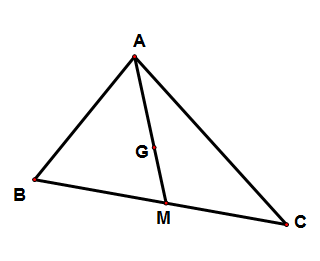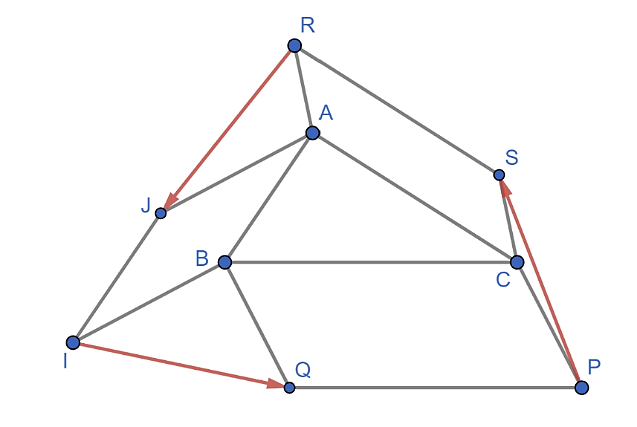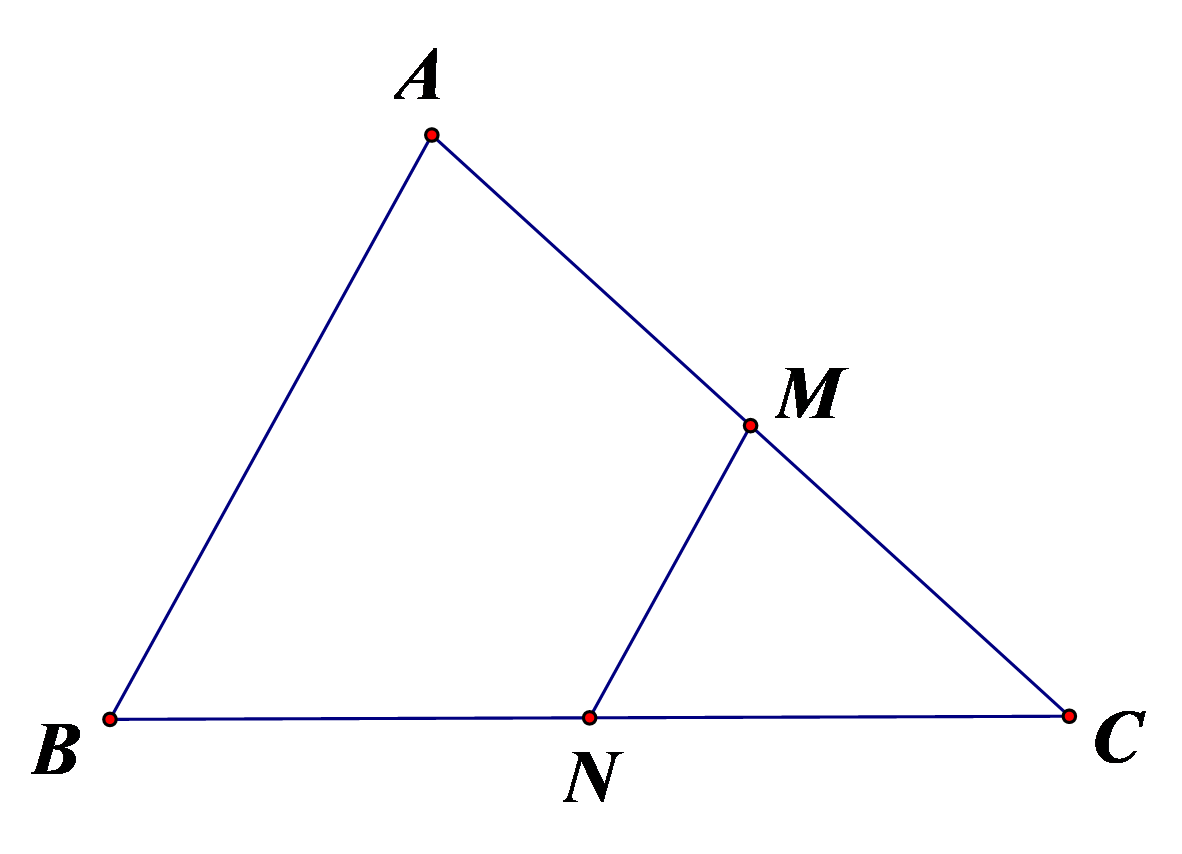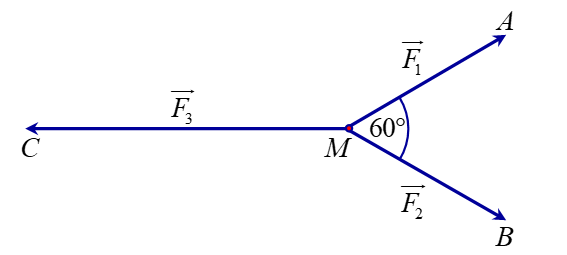Cho tam giác\[ABC\] với trung tuyến \[AM\] và trọng tâm \[G\].
a) \(\overrightarrow {AB} - \overrightarrow {AC} = \overrightarrow {BC} \).
b) \(\overrightarrow {GA} + \overrightarrow {GB} + \overrightarrow {GC} = \overrightarrow {MC} + \overrightarrow {MB} \).
c) Vectơ \(\overrightarrow {AG} + \overrightarrow {GM} \) cùng phương với vectơ \(\overrightarrow {MG} \).
d) \(\overrightarrow {AG} + \overrightarrow {MC} = \overrightarrow {MG} + \overrightarrow {BC} \).
Cho tam giác\[ABC\] với trung tuyến \[AM\] và trọng tâm \[G\].
a) \(\overrightarrow {AB} - \overrightarrow {AC} = \overrightarrow {BC} \).
b) \(\overrightarrow {GA} + \overrightarrow {GB} + \overrightarrow {GC} = \overrightarrow {MC} + \overrightarrow {MB} \).
c) Vectơ \(\overrightarrow {AG} + \overrightarrow {GM} \) cùng phương với vectơ \(\overrightarrow {MG} \).
d) \(\overrightarrow {AG} + \overrightarrow {MC} = \overrightarrow {MG} + \overrightarrow {BC} \).
Quảng cáo
Trả lời:

a) Sai. Theo quy tắc hiệu, ta có \(\overrightarrow {AB} - \overrightarrow {AC} = \overrightarrow {CB} \).
b) Đúng. Vì \[G\] là trọng tâm tam giác\[ABC\] nên \(\overrightarrow {GA} + \overrightarrow {GB} + \overrightarrow {GC} = \overrightarrow 0 \).
Lại có M là trung điểm của BC nên \(\overrightarrow {MC} + \overrightarrow {MB} = \overrightarrow 0 \).
Vậy \(\overrightarrow {GA} + \overrightarrow {GB} + \overrightarrow {GC} = \overrightarrow {MC} + \overrightarrow {MB} \).
c) Đúng. Ta có \(\overrightarrow {AG} + \overrightarrow {GM} = \overrightarrow {AM} \) cùng phương với vectơ \(\overrightarrow {MG} \).
d) Sai. Ta có \(\overrightarrow {AG} + \overrightarrow {MC} = \overrightarrow {MG} + \overrightarrow {BC} \Leftrightarrow \overrightarrow {AG} + \overrightarrow {MC} - \overrightarrow {MG} = \overrightarrow {BC} \Leftrightarrow \overrightarrow {AG} + \overrightarrow {GC} = \overrightarrow {BC} \)
\( \Leftrightarrow \overrightarrow {AC} = \overrightarrow {BC} \Rightarrow A \equiv B\) là sai vì \[A\],\[B\] phân biệt.
Hot: Học hè online Toán, Văn, Anh...lớp 1-12 tại Vietjack với hơn 1 triệu bài tập có đáp án. Học ngay
- Trọng tâm Toán, Văn, Anh 10 cho cả 3 bộ KNTT, CTST, CD VietJack - Sách 2025 ( 13.600₫ )
- Sách - Sổ tay kiến thức trọng tâm Vật lí 10 VietJack - Sách 2025 theo chương trình mới cho 2k9 ( 31.000₫ )
- Sách lớp 10 - Combo Trọng tâm Toán, Văn, Anh và Lí, Hóa, Sinh cho cả 3 bộ KNTT, CD, CTST VietJack ( 75.000₫ )
- Sách lớp 11 - Trọng tâm Toán, Lý, Hóa, Sử, Địa lớp 11 3 bộ sách KNTT, CTST, CD VietJack ( 52.000₫ )
CÂU HỎI HOT CÙNG CHỦ ĐỀ
Lời giải

a) Đúng. Theo quy tắc ba điểm, ta có \(\overrightarrow {RJ} = \overrightarrow {RA} + \overrightarrow {AJ} \).
b) Sai. Ta có \(\overrightarrow {IQ} = \overrightarrow {IB} + \overrightarrow {BQ} \).
c) Sai. Ta có \(\overrightarrow {PS} = \overrightarrow {PC} + \overrightarrow {CS} \).
d) Đúng. Do \(CARS\) là hình bình hành nên \(\overrightarrow {RA} = \overrightarrow {SC} \).
Do \(ABIJ\) là hình bình hành nên \(\overrightarrow {AJ} = - \overrightarrow {IB} \).
Khi đó, \(\overrightarrow {RJ} = \overrightarrow {RA} + \overrightarrow {AJ} = \overrightarrow {SC} - \overrightarrow {IB} \).
Do \(BCPQ\) là hình bình hành nên \(\overrightarrow {BQ} = \overrightarrow {CP} \).
Khi đó, \(\overrightarrow {IQ} = \overrightarrow {IB} + \overrightarrow {BQ} = \overrightarrow {IB} + \overrightarrow {CP} \).
Vậy ta có \(\overrightarrow {RJ} + \overrightarrow {IQ} + \overrightarrow {PS} \)\[ = \left( {\overrightarrow {SC} - \overrightarrow {IB} } \right) + \left( {\overrightarrow {IB} + \overrightarrow {CP} } \right) + \left( {\overrightarrow {PC} + \overrightarrow {CS} } \right)\]\(\)
\( = \left( {\overrightarrow {SC} + \overrightarrow {CS} } \right) + \left( {\overrightarrow {IB} - \overrightarrow {IB} } \right) + \left( {\overrightarrow {CP} + \overrightarrow {PC} } \right) = \overrightarrow 0 \).
Vậy \(\overrightarrow {RJ} + \overrightarrow {IQ} + \overrightarrow {PS} = \vec 0\).
Lời giải

a) Đúng. Ta có \(MN\) là đường trung bình của tam giác \(ABC\) nên \(MN = \frac{1}{2}AB\).
b) Đúng. Vì \(N\) là trung điểm của \(BC\) nên \(\overrightarrow {NB} = \overrightarrow {CN} \).
c) Sai. Theo quy tắc hiệu, ta có \(\overrightarrow {CM} - \overrightarrow {CN} = \overrightarrow {NM} \).
d) Đúng. Ta có \(\left| {\overrightarrow {CM} - \overrightarrow {NB} } \right| = \left| {\overrightarrow {CM} - \overrightarrow {CN} } \right| = \left| {\overrightarrow {NM} } \right| = MN = \frac{{AB}}{2} = \frac{a}{2}\).
Lời giải
Bạn cần đăng ký gói VIP ( giá chỉ từ 199K ) để làm bài, xem đáp án và lời giải chi tiết không giới hạn.
Lời giải
Bạn cần đăng ký gói VIP ( giá chỉ từ 199K ) để làm bài, xem đáp án và lời giải chi tiết không giới hạn.
Lời giải
Bạn cần đăng ký gói VIP ( giá chỉ từ 199K ) để làm bài, xem đáp án và lời giải chi tiết không giới hạn.
Lời giải
Bạn cần đăng ký gói VIP ( giá chỉ từ 199K ) để làm bài, xem đáp án và lời giải chi tiết không giới hạn.

